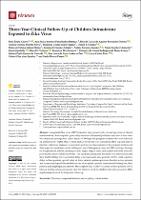Three-Year Clinical Follow-Up of Children Intrauterine Exposed to Zika Virus

View
Author
Date
2021-03-22Permanent link
https://hdl.handle.net/11351/6566DOI
10.3390/v13030523
ISSN
1999-4915
WOS
000634247700001
PMID
33810110
Abstract
Congenital Zika virus (ZIKV) infection may present with a broad spectrum of clinical manifestations. Some sequelae, particularly neurodevelopmental problems, may have a later onset. We conducted a prospective cohort study of 799 high-risk pregnant women who were followed up until delivery. Eighty-three women and/or newborns were considered ZIKV exposed and/or infected. Laboratory diagnosis was made by polymerase chain reaction in the pregnant mothers and their respective newborns, as well as Dengue virus, Chikungunya virus, and ZIKV serology. Serology for toxoplasmosis, rubella, cytomegalovirus, herpes simplex virus, and syphilis infections were also performed in microcephalic newborns. The newborns included in the study were followed up until their third birthday. Developmental delay was observed in nine patients (13.2%): mild cognitive delay in three patients, speech delay in three patients, autism spectrum disorder in two patients, and severe neurological abnormalities in one microcephalic patient; sensorineural hearing loss, three patients and dysphagia, six patients. Microcephaly due to ZIKV occurred in three patients (3.6%). Clinical manifestations can appear after the first year of life in children infected/exposed to ZIKV, emphasizing the need for long-term follow-up.
Keywords
Zika virus; Congenital infection; MicrocephalyBibliographic citation
Gazeta RE, Bertozzi APAP, Dezena RCAB, Silva ACB, Fajardo TCG, Catalan DT, et al. Three-Year Clinical Follow-Up of Children Intrauterine Exposed to Zika Virus. Viruses. 2021 Mar 22;13:523.
Audience
Professionals
This item appears in following collections
- HVH - Articles científics [4476]
- VHIR - Articles científics [1751]
The following license files are associated with this item:

 Private area
Private area Contact Us
Contact Us







